Independent Lab Testing of Supplements: Why It Matters, How It Works, and What to Look For
Abstract / Summary
Independent lab testing is a cornerstone of supplement transparency, offering scientific verification of ingredient accuracy, purity, and safety in a largely self-regulated industry. This article explores how independent testing works, what labs evaluate, why it differs from in-house analysis, and how to interpret a real Certificate of Analysis (COA). It also outlines how consumers, clinicians, and brands can use third-party testing to build trust, reduce risk, and navigate misleading marketing claims. With insights into analytical methods like HPLC, ICP-MS, DNA barcoding, and dissolution testing, this piece serves as a comprehensive guide to understanding supplement quality in an era of rising consumer expectations and evolving regulation.
By Sighed Effects — May 4, 2025
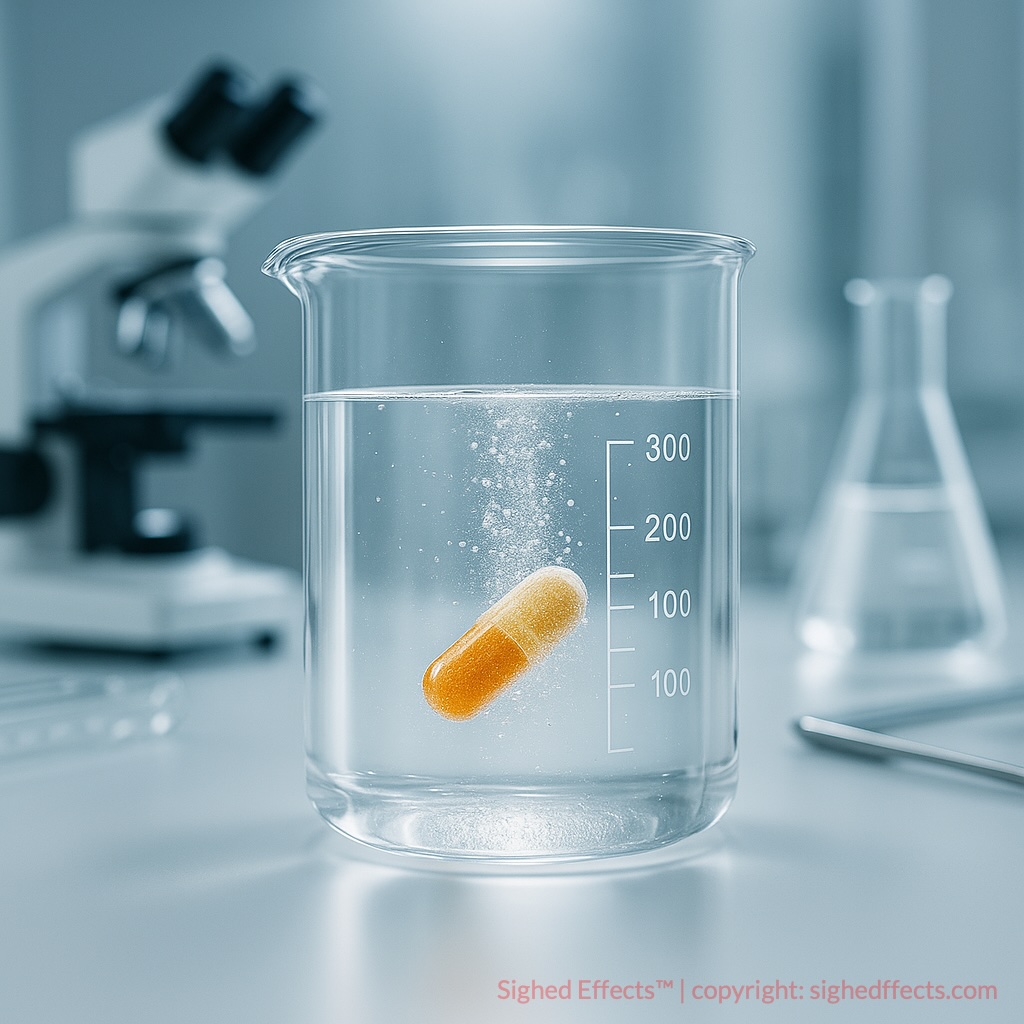
Table of Contents
- What Is Independent Lab Testing?
- Why the FDA Doesn’t Require It
- What Independent Labs Actually Test For
- Label Accuracy and Dosage Verification
- Ingredient Substitution and Adulteration
- Contaminants and Safety Testing
- Botanical Identity and DNA Authentication
- Disintegration and Bioavailability Testing
- Stability and Oxidation in Sensitive Products
- Analytical Methods Used in Supplement Testing
- HPLC: Quantifying Active Ingredients
- ICP-MS: Detecting Trace Metals
- GC-MS: Identifying Synthetic Compounds
- TLC: Herbal Verification at Low Cost
- DNA Barcoding for Species Identification
- Microbial and Allergen Testing
- Oxidation Testing for Oils
- Disintegration and Dissolution Timing
- The Difference Between In-House vs. Independent Testing
- Who Performs These Tests?
- How Brands Use (or Misuse) Lab Test Claims
- How to Verify a Real Independent Test Report
- Independent Testing and Consumer Trust
- The Future of Supplement Lab Testing
What Is Independent Lab Testing?
Independent lab testing refers to the scientific analysis of a dietary supplement performed by a third-party laboratory with no financial stake in the brand or product being tested. These tests are conducted to verify the contents of the supplement, assess its purity, detect potential contaminants, and ensure that the product matches its label claims. Independent testing plays a critical role in the supplement industry because it provides an external check on a largely self-regulated market.
In the United States, dietary supplements are regulated by the Food and Drug Administration (FDA) under the Dietary Supplement Health and Education Act (DSHEA) of 1994. However, manufacturers are not required to submit their products for approval or verification before they go to market. This means that, unless a problem arises post-distribution, a supplement may never undergo laboratory analysis at all. Independent testing fills this gap by proactively analyzing what’s inside the bottle, not just what’s on the label.
An independent lab is typically a facility accredited under standards such as ISO/IEC 17025, which certifies that the lab follows proper quality control procedures and uses validated analytical methods. These labs may be private analytical service providers, university-affiliated laboratories, or nonprofit organizations specializing in consumer protection. Their primary function is to produce objective, scientifically reliable data that can be used by brands, consumers, clinicians, and regulatory bodies alike.
The independence of the laboratory is essential. If a lab is owned or controlled by the supplement brand, or if its results are influenced by a marketing contract, the credibility of the data becomes questionable. Independent labs, on the other hand, are paid for the testing service, not the outcome. They do not benefit from positive results, and their reputation depends on scientific neutrality.
For consumers, independent lab testing can help confirm whether a product actually contains the active ingredients it claims—and whether those ingredients are present in the stated amounts. For example, if a product says it contains 400 mg of magnesium glycinate, an independent lab test can confirm that quantity and identify whether other, cheaper forms of magnesium have been substituted. Similarly, these tests can screen for unwanted contaminants like lead, cadmium, arsenic, mercury, mold, bacteria, and residual solvents.
Importantly, independent testing doesn’t just protect consumers. It also helps responsible supplement companies build credibility in a crowded and often skeptical market. Brands that voluntarily submit their products for third-party analysis—and publish the results—demonstrate a level of transparency that consumers increasingly expect. Independent lab reports, when authentic and verifiable, can serve as powerful trust signals.
As the supplement market continues to grow globally, the demand for credible, science-based verification systems grows with it. Independent lab testing is not a regulatory requirement, but it is quickly becoming a market expectation. Consumers are no longer satisfied with vague claims or unverified “proprietary blends.” They want to know what they’re putting in their bodies—and they want the data to back it up.
In the sections that follow, we’ll explore why the FDA does not mandate independent testing, what kinds of analyses these labs perform, the methodologies used, and how to interpret the resulting data. Whether you’re a consumer, a clinician, or a brand, understanding the role of independent testing is essential for making evidence-based decisions about dietary supplements.
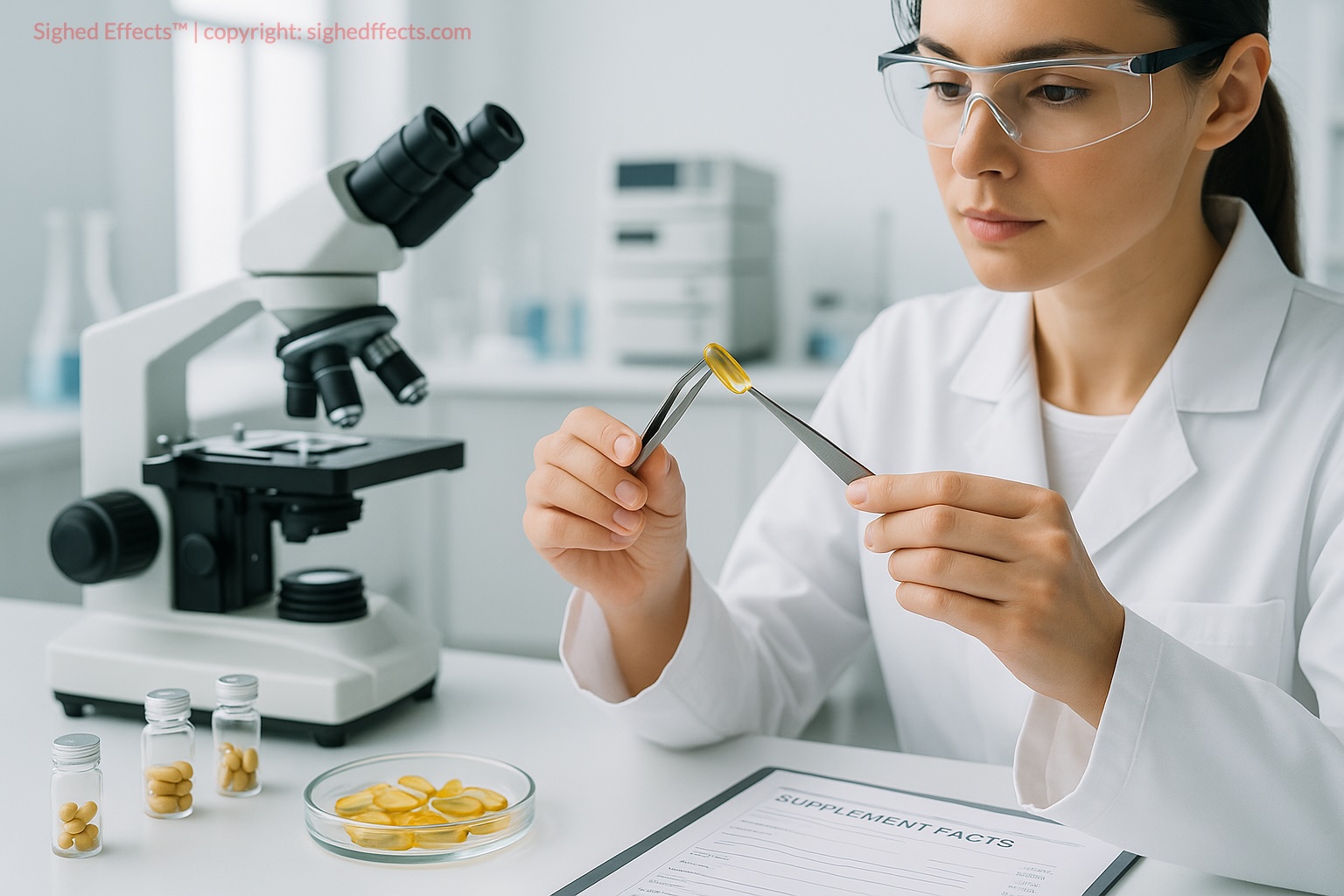
Why the FDA Doesn’t Require It
Unlike pharmaceutical drugs, dietary supplements are not subject to premarket approval or mandatory testing by the U.S. Food and Drug Administration (FDA). This is due to the regulatory framework established by the Dietary Supplement Health and Education Act (DSHEA) of 1994, which legally defined supplements as a category of food, not drugs. As a result, supplement manufacturers are responsible for ensuring the safety and labeling accuracy of their own products—but they are not required to prove these claims through independent lab testing before selling them.
Under DSHEA, the burden of proof lies with the FDA—but only after a product is already on the market. If a supplement is adulterated, misbranded, or causing harm, the FDA can intervene and take enforcement action, including product recalls, warning letters, or legal penalties. However, this is a reactive process, not a proactive one. Unless a red flag is raised through adverse event reporting, independent research, or whistleblowing, many supplements may go years without scrutiny.
This lack of premarket testing has led to substantial variability in supplement quality. Independent analyses—including those by Labdoor, Consumer Reports, and academic labs—have found widespread discrepancies between label claims and actual ingredient content, as well as frequent contamination with heavy metals, microbial toxins, or undeclared substances. In some cases, supplements have even been found to contain pharmaceutical drugs or banned stimulants not listed on the label.
Despite these issues, regulatory reform has been slow. Efforts to modernize DSHEA or introduce mandatory testing requirements have met resistance from both industry groups and legislators concerned about overregulation. The supplement industry is a multibillion-dollar market with powerful lobbying interests, and many manufacturers argue that stricter requirements would raise costs, stifle innovation, and reduce access to wellness products.
From the FDA’s perspective, limited resources also play a role. The agency oversees a vast range of food, drug, cosmetic, and supplement products, and only a small fraction of its budget is allocated to dietary supplement enforcement. Instead, the FDA encourages voluntary compliance with current good manufacturing practices (cGMPs) and relies on post-market tools such as inspections, adverse event monitoring, and consumer complaints to identify problematic products.
This creates a regulatory environment in which a supplement can be legally sold without ever being tested by an independent lab—unless the brand chooses to do so voluntarily. This is in stark contrast to pharmaceutical products, which must pass multiple stages of clinical trials and quality assurance before receiving approval. For supplements, the lack of a gatekeeping process places a greater burden on consumers, clinicians, and watchdog organizations to identify high-quality products.
The implication is clear: the absence of required testing does not mean supplements are always safe or accurately labeled. It means that consumers must do their own due diligence—or rely on brands that demonstrate transparency through independent verification. In this landscape, third-party lab testing becomes a form of self-regulation that separates responsible manufacturers from opportunistic ones.
In the next section, we’ll look more closely at what independent labs actually test for—moving beyond the concept and into the chemistry that reveals a supplement’s true profile.
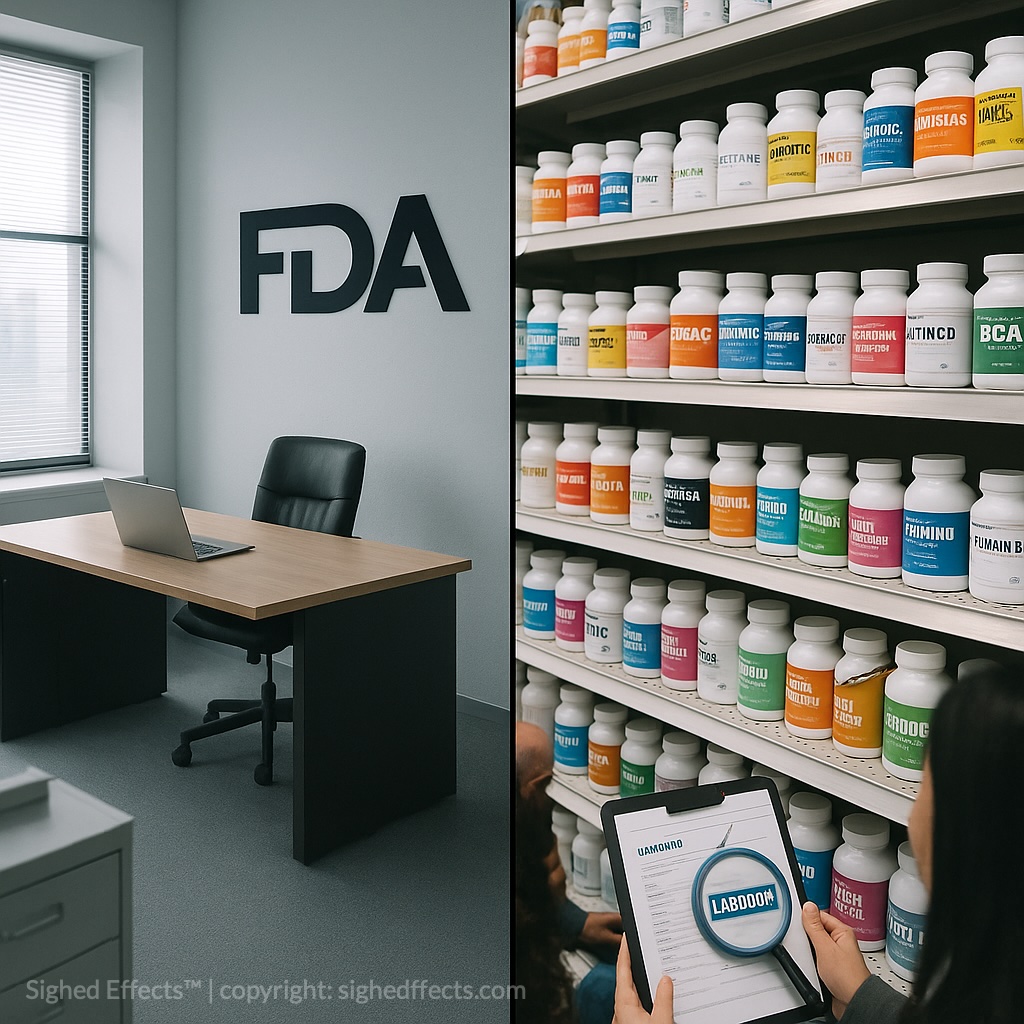
What Independent Labs Actually Test For
Independent laboratories perform a comprehensive range of analytical tests to evaluate the quality, safety, and accuracy of dietary supplements. These tests go far beyond visual inspection or basic ingredient confirmation. In most cases, the lab is tasked with chemically verifying what the product contains, whether it matches the label claims, and whether it contains anything it shouldn’t. This data forms the backbone of third-party certifications and consumer trust in the supplement marketplace.
Label Accuracy and Dosage Verification
One of the primary tests is for label accuracy. This means quantifying the amount of each active ingredient listed on the supplement label and verifying whether it matches the declared dosage. For example, if a product claims to contain 250 mg of ashwagandha extract per capsule, the lab will use techniques like HPLC (high-performance liquid chromatography) to determine the actual concentration of active withanolides. A deviation of more than 10% from the labeled amount is typically considered a failure.
Ingredient Substitution and Adulteration
In addition to active ingredients, labs test for ingredient substitution or adulteration. This involves identifying whether the labeled compound is present in the correct form and whether other undeclared substances have been added. In some protein powders, for example, manufacturers may “amino spike” the formula by adding cheap amino acids like glycine or taurine to inflate the protein content. DNA barcoding and spectroscopy can help detect such fraudulent substitutions.
Contaminants and Safety Testing
Independent labs also screen for a wide range of contaminants, including:
- Heavy metals such as lead, arsenic, cadmium, and mercury
- Microbial contamination including E. coli, Salmonella, mold, and yeast
- Residual solvents used in extraction processes
- Undeclared drugs or synthetic compounds (e.g., sibutramine in weight loss pills)
- Pesticide residues in plant-based ingredients
These contaminants may be present due to poor manufacturing practices, raw material sourcing, or environmental exposure. While many are found at trace levels, repeated exposure—especially from daily supplements—can accumulate and cause harm. For example, chronic lead exposure has been linked to cardiovascular and neurological damage, even at low doses.
Botanical Identity and DNA Authentication
Some independent labs also analyze ingredient bioidentity—verifying that herbal ingredients are derived from the correct plant species and parts (e.g., root vs. leaf). This is particularly important in categories like traditional Chinese medicine or Ayurvedic supplements, where different parts of a plant may have different effects or safety profiles. DNA authentication and thin-layer chromatography (TLC) are commonly used in these cases.
Disintegration and Bioavailability Testing
Testing for disintegration and dissolution is another important area, especially for tablets and capsules. A supplement may contain the correct dose of an ingredient but fail to break down properly in the gastrointestinal tract. Labs use USP protocols to test whether the capsule dissolves within a set time period under simulated stomach or intestinal conditions.
Stability and Oxidation in Sensitive Products
Finally, some labs provide testing for shelf stability and oxidation. This is especially relevant for products like fish oil, where rancidity can affect both taste and safety. Peroxide value (PV) and anisidine value (AV) are standard metrics used to assess the oxidative status of lipids. A high AV or PV suggests the product is already degrading or poorly protected by antioxidants.
Together, these testing domains create a multidimensional profile of a supplement’s quality. They move beyond surface-level claims and enter the realm of scientific verification—empowering consumers, clinicians, and regulators to make informed decisions. In the next section, we’ll explore the specific analytical methods labs use to generate this data—and why not all methods are created equal.
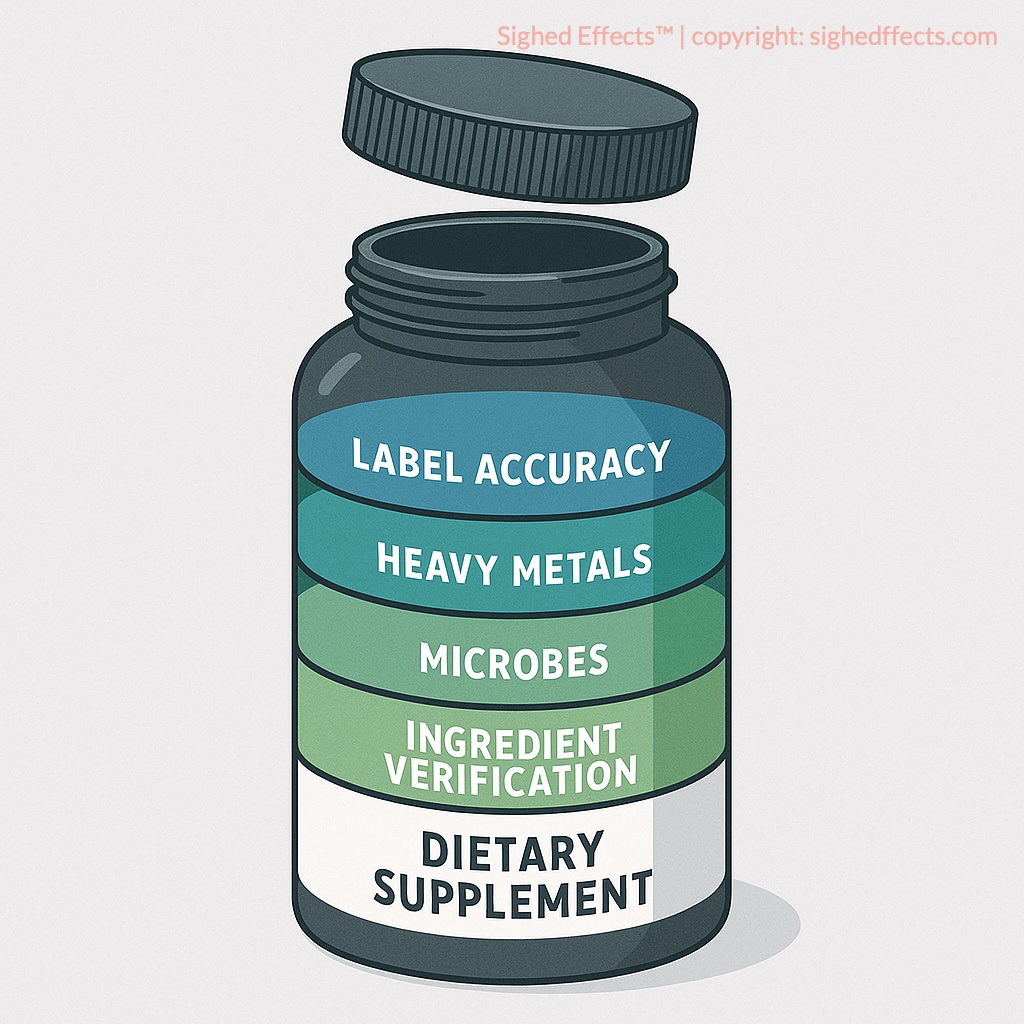
Analytical Methods Used in Supplement Testing
Independent laboratories use a range of advanced analytical techniques to assess the chemical makeup, safety, and stability of dietary supplements. These methods are chosen based on the type of ingredient being tested, the matrix of the supplement (e.g., powder, capsule, oil), and the nature of the information being sought—whether quantitative (how much is present) or qualitative (what is present). Each method has strengths, limitations, and preferred use cases. Understanding these tools provides insight into the rigor and reliability of lab testing.
HPLC: Quantifying Active Ingredients
One of the most widely used tools is High-Performance Liquid Chromatography (HPLC). This method separates compounds in a liquid mixture and measures their concentration using UV detection or mass spectrometry. HPLC is especially useful for quantifying vitamins, herbal constituents (like polyphenols or withanolides), amino acids, and certain synthetic compounds. It provides highly accurate data and is often considered a gold standard for quantitative analysis.
ICP-MS: Detecting Trace Metals
For minerals and metals, labs typically use Inductively Coupled Plasma Mass Spectrometry (ICP-MS). This highly sensitive technique ionizes the sample using a plasma torch and then analyzes the ions based on their mass-to-charge ratio. ICP-MS can detect trace amounts of heavy metals like lead, cadmium, arsenic, and mercury at parts-per-billion levels. It is the preferred method for contaminant screening in both supplements and food products.
GC-MS: Identifying Synthetic Compounds
Gas Chromatography-Mass Spectrometry (GC-MS) is used for volatile or semi-volatile compounds, such as essential oils, residual solvents, or some synthetic adulterants. It is particularly valuable for identifying illegal or undeclared drugs added to performance or weight loss supplements. GC-MS can identify chemical fingerprints of banned substances with extremely high specificity.
TLC: Herbal Verification at Low Cost
Thin-Layer Chromatography (TLC) is a lower-cost, semi-quantitative method used for herbal identification. It works by applying plant extracts to a silica-coated plate, which is then developed in a solvent to separate compounds based on polarity. The resulting pattern—sometimes called a “fingerprint”—can be compared to authenticated standards to confirm botanical identity.
DNA Barcoding for Species Identification
DNA barcoding is another tool used to confirm the species identity of botanical ingredients. This method analyzes short, standardized segments of genetic material and compares them to known plant DNA databases. While powerful for identifying unprocessed herbs, DNA barcoding becomes less effective with heavily processed extracts, where genetic material may be degraded.
Microbial and Allergen Testing
For microbiological testing, labs rely on methods such as plate culturing, polymerase chain reaction (PCR), and enzyme-linked immunosorbent assay (ELISA). These can detect and quantify harmful bacteria like Salmonella, E. coli, and yeast/mold species. ELISA is also commonly used for detecting allergens or contaminants like gluten and peanut proteins.
Oxidation Testing for Oils
In oxidation testing, especially relevant to oils and fatty acid supplements, Peroxide Value (PV) and Anisidine Value (AV) are used to evaluate the freshness and degradation of lipids. These tests provide insight into the shelf stability of products like fish oil, flaxseed oil, or krill oil—and help detect rancidity before it becomes apparent through taste or smell.
Disintegration and Dissolution Timing
Finally, disintegration and dissolution testing is used to simulate how a tablet or capsule behaves in the gastrointestinal tract. USP guidelines define specific time windows in which a dosage form must break down and release its active ingredients. These tests are especially important for supplements that rely on bioavailability for efficacy, such as magnesium, curcumin, or time-released formulas.
Each of these methods is selected based on the analytical target, cost, required sensitivity, and regulatory standards. While no single method can test everything, a well-constructed testing protocol will typically involve a combination of these tools to provide a full-spectrum analysis. In the next section, we’ll explore why using an independent lab—not the brand’s own testing—makes all the difference in transparency and trust.
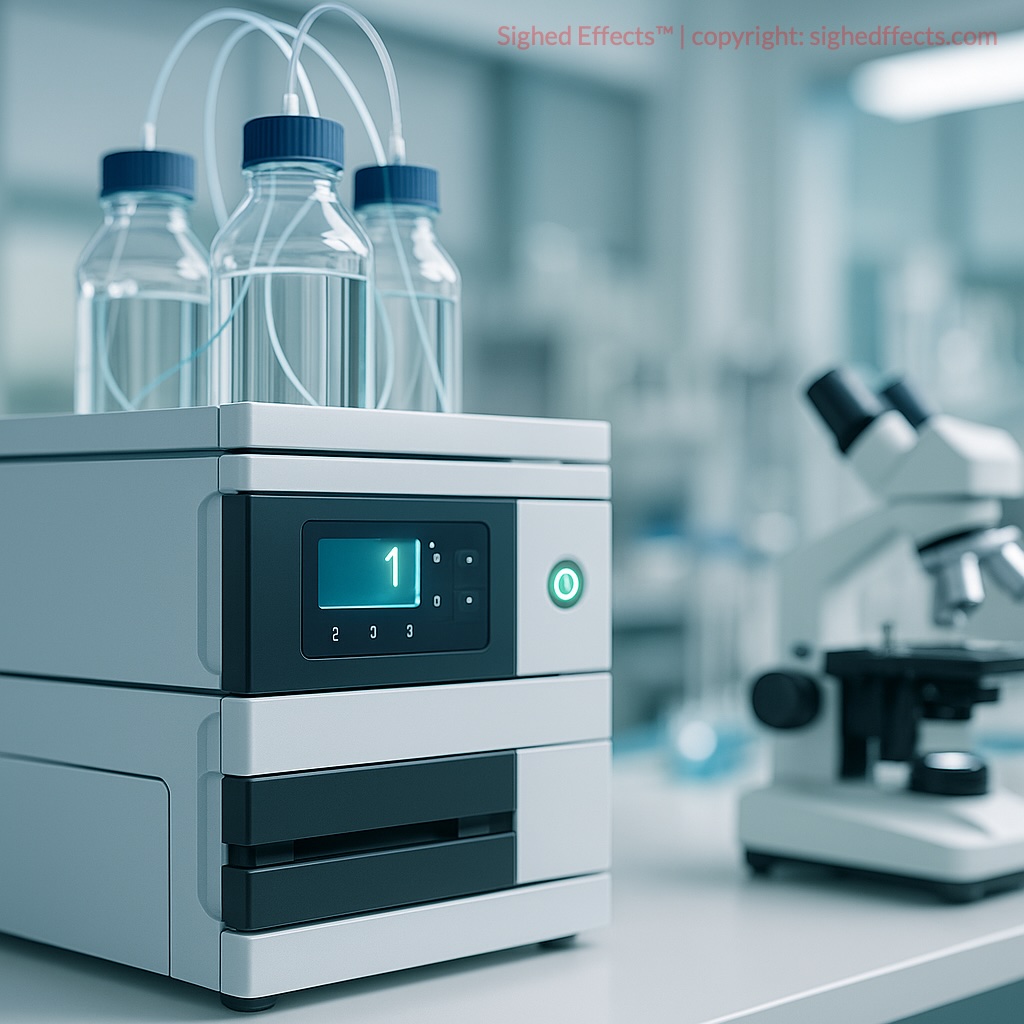
The Difference Between In-House vs. Independent Testing
In the supplement industry, the distinction between in-house testing and independent lab testing is critical—but often misunderstood. Both serve important functions, but they are not interchangeable. Understanding the differences in objectivity, methodology, and consumer perception can help clarify why independent testing carries more weight, especially when evaluating supplement credibility and label accuracy.
In-house testing is conducted by the supplement company itself or by a laboratory it directly owns or contracts. This may occur during the manufacturing process or as part of internal quality control. In-house labs often test raw materials upon arrival, confirm ingredient identities, and perform batch-release tests to ensure that finished products meet certain specifications. These are valuable steps, especially for companies operating under good manufacturing practices (GMP), but they are not necessarily independent or unbiased.
The key issue with in-house testing is the potential for conflict of interest. Because the manufacturer controls both the product and the data, there is inherent incentive to publish favorable results or withhold data that could damage sales. Even if the science is sound, the lack of separation between the business and the test outcome can create skepticism—particularly among consumers, regulators, or clinicians who are trained to question internal data when no third-party validation is available.
Independent testing, by contrast, is performed by a laboratory that has no financial or operational ties to the supplement manufacturer. The lab is paid for the service of conducting the analysis—not for the result. These labs are typically ISO/IEC 17025-accredited, meaning they follow internationally recognized standards for testing procedures, data integrity, and equipment calibration. Their findings are considered more credible because their reputation depends on scientific objectivity, not product sales.
Another difference lies in how samples are selected. In-house tests often rely on samples pulled during production or submitted by the brand itself. Independent testing—when done rigorously—uses blind sampling methods, such as purchasing supplements from public retailers or receiving sealed, batch-labeled samples through a verified chain of custody. This reduces the chance of “clean” or “cherry-picked” samples being tested instead of the real-world product reaching consumers.
Additionally, the testing scope may vary. In-house labs typically focus on the brand’s internal benchmarks, such as ingredient identity, potency, and microbial safety. Independent labs are more likely to run comprehensive testing for contaminants, cross-check ingredient forms, verify species identity, and evaluate label accuracy down to the milligram. Because they serve multiple clients and industries, independent labs also have access to a broader range of equipment and analytical methods.
From a regulatory standpoint, both types of testing can support documentation required by the FDA in the event of an inspection or compliance audit. However, **only independent testing offers objective evidence** that can be used in public marketing or consumer trust campaigns without triggering skepticism about bias or manipulation. That’s why third-party verification seals carry such weight in both direct-to-consumer and practitioner-based supplement markets.
To be clear, in-house testing is not inherently untrustworthy. Many reputable companies invest heavily in their internal quality control infrastructure and follow best practices. But even the most ethical brands benefit from an outside audit. Independent lab testing provides an extra layer of accountability—both scientifically and reputationally—that no amount of internal oversight can replicate.
In the next section, we’ll explore the landscape of who actually performs independent testing: from global contract labs and academic facilities to specialized consumer advocacy labs that publish public-facing results.
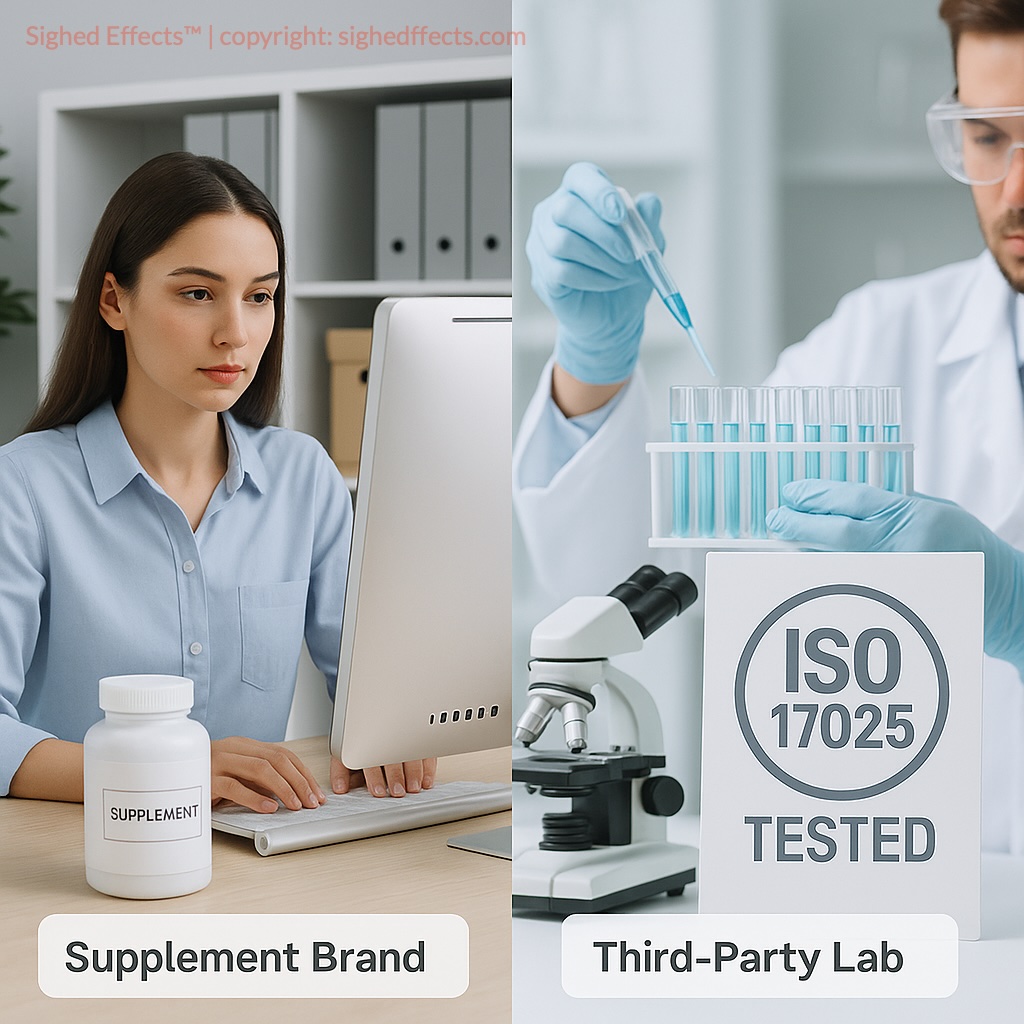
Who Performs These Tests?
Independent supplement testing is carried out by a range of professional laboratories, each with varying levels of specialization, accreditation, and transparency. These entities may include contract testing laboratories, academic research centers, nonprofit consumer organizations, and even government-affiliated facilities. While their goals may differ, they all serve the same essential function: to provide objective data about the contents and quality of dietary supplements.
The most common type of facility is the contract analytical laboratory. These labs operate as third-party service providers and offer testing for a wide array of industries, including pharmaceuticals, food, cosmetics, and dietary supplements. Examples include Eurofins, NSF International Labs, Covance, and Intertek. These organizations have large infrastructures, maintain ISO/IEC 17025 accreditation, and are capable of performing high-throughput testing using advanced instrumentation like HPLC, GC-MS, and ICP-MS.
These labs are often used by supplement brands for internal quality control, regulatory compliance, or to support third-party certification programs. However, unless the results are made public, the testing remains behind closed doors. The credibility of the data depends on both the rigor of the lab and the transparency of the brand presenting the results.
A second category includes academic laboratories, such as those based at universities with strong pharmacology, toxicology, or analytical chemistry departments. These labs often conduct supplement testing as part of independent research projects or collaborations with consumer advocacy groups. Academic labs benefit from scientific oversight, peer review, and typically lack any financial ties to the supplement industry—enhancing their perceived objectivity.
While academic labs are not commercial testing providers, they have published some of the most influential supplement quality studies to date. For example, researchers at institutions like Harvard, Johns Hopkins, and the University of Mississippi have led investigations into the presence of undeclared stimulants, inaccurate labeling, or contaminant loads in widely sold products.
A growing sector is the emergence of nonprofit consumer testing organizations. These labs are typically funded by donations, memberships, or product testing fees and are dedicated to providing publicly accessible, unbiased data. Examples include ConsumerLab.com and Labdoor. These organizations purchase supplements directly from the market—just like a consumer would—and publish their results, often with rankings, scores, or quality seals.
What distinguishes these groups is their focus on transparency and accessibility. By releasing test results publicly, they create accountability loops that drive reform across the industry. Brands are often pressured to respond to poor results, reformulate problematic products, or voluntarily submit updated testing data. This model turns independent testing into a form of public health advocacy.
In some regions, government-affiliated laboratories may also engage in supplement testing. While this is rare in the United States, international models like Health Canada or the European Food Safety Authority (EFSA) occasionally test suspect supplements or evaluate risk categories through targeted sampling. These labs often operate under strict public standards but usually focus on enforcement rather than consumer education.
The common thread across all these laboratories is that they maintain independence from the brand under evaluation. Whether a lab is public, private, academic, or nonprofit, its value to the supplement consumer hinges on the integrity of its methodology and the accessibility of its results. In the next section, we’ll turn to how some brands misuse the concept of lab testing—and how consumers can spot misleading claims.
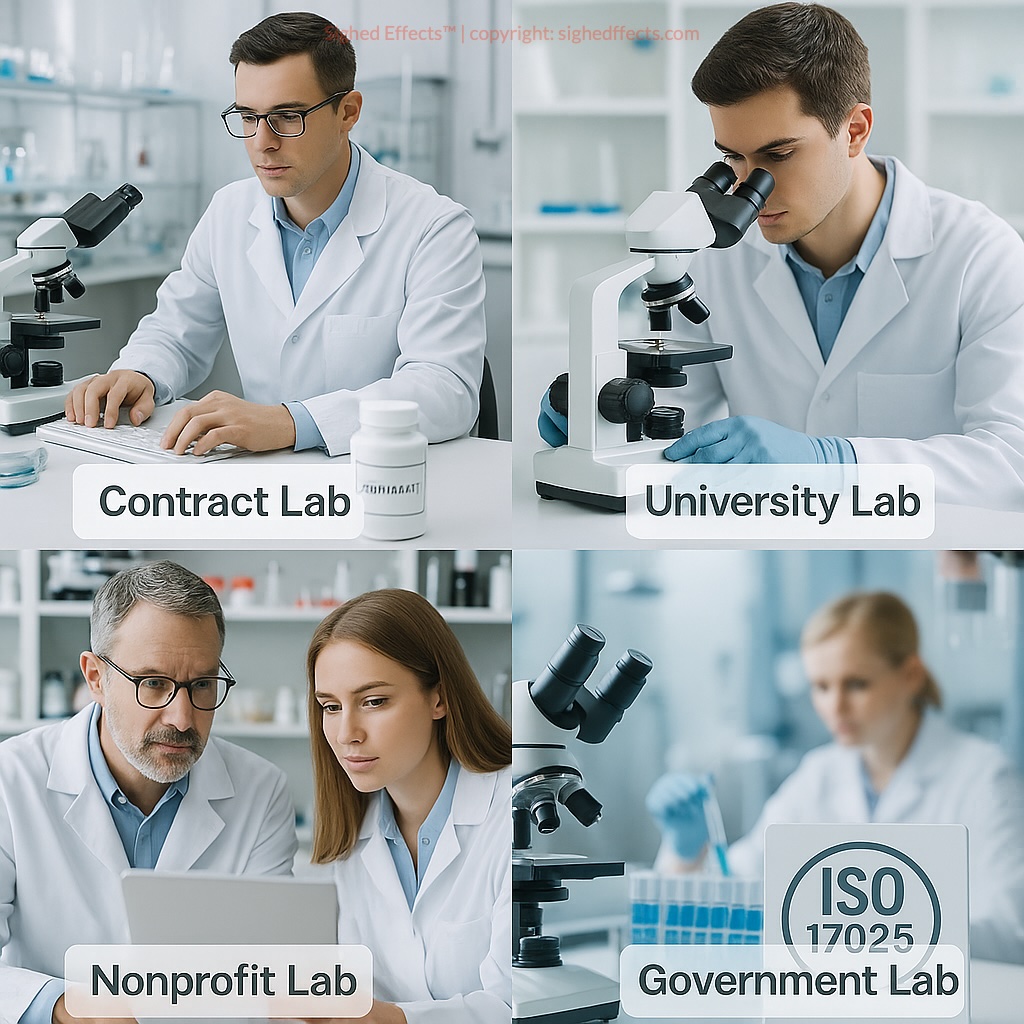
How Brands Use (or Misuse) Lab Test Claims
As consumer demand for supplement transparency has grown, so has the number of brands publicly claiming that their products are “lab tested” or “third-party verified.” However, these terms are often used loosely—and sometimes deceptively. Without oversight, brands can manipulate language and presentation to create the illusion of scientific validation, even when the testing performed is minimal, outdated, or irrelevant to the product’s safety and efficacy.
One common tactic is to label a product as “lab tested” without specifying who performed the testing. This could refer to in-house testing, basic ingredient confirmation, or even batch-level inspection of a raw material. In many cases, the testing may not cover the finished product, the declared dosage, or the presence of contaminants. The phrase itself is not regulated, which means it can be applied liberally to create a false sense of quality assurance.
Another strategy is selective disclosure. A brand might publish favorable test results from a single batch but fail to mention that subsequent batches were not tested, or that prior tests failed. This cherry-picking undermines the spirit of third-party verification, which depends on reproducibility and statistical reliability. If a supplement is sold continuously, its quality needs to be demonstrated across time and production lots—not just once.
Some companies also misuse Certificates of Analysis (COAs) by either fabricating them, issuing them in-house, or removing identifying information from legitimate lab documents. A proper COA should include the name of the independent lab, date of analysis, batch number, list of tests performed, methods used, and pass/fail results. If a COA is vague, unbranded, or lacks method specificity, it may be meaningless.
Perhaps the most egregious example is “borrowed validation”—when a brand relies on supplier testing data or cites the reputation of a raw material manufacturer as proof of quality. While supplier testing can be useful upstream, it does not guarantee the integrity of the final blended, encapsulated, and packaged product. Without testing the actual retail-ready supplement, all downstream risks remain unaddressed.
Additionally, some brands use third-party seals or logos in misleading ways. For example, displaying an NSF or USP badge in marketing materials even when the specific product being sold has not been certified by those bodies. This tactic exploits consumer recognition of high-trust symbols, while bypassing the rigorous requirements those certifications entail. In some cases, use of such seals without permission may even constitute trademark infringement.
From a consumer standpoint, these tactics blur the line between science and marketing. When a brand claims its supplement is “lab tested,” that should mean the product has undergone meaningful, independent analysis for purity, potency, and contamination—not that the ingredients were simply checked on arrival. The absence of standardized language around testing terms allows for a wide range of interpretations—and abuses.
Fortunately, some transparency tools exist. Brands that conduct legitimate third-party testing will often:
- Publish batch-specific COAs linked by lot number
- Name the laboratory used and confirm it is ISO 17025-accredited
- Describe what was tested (e.g., heavy metals, active ingredients, microbes)
- Update testing data when formulations or batches change
- Provide customer service support for testing-related questions
In the next section, we’ll walk through how to evaluate a supplement’s testing claims by examining the lab report or Certificate of Analysis itself—what to look for, what to question, and when to walk away.
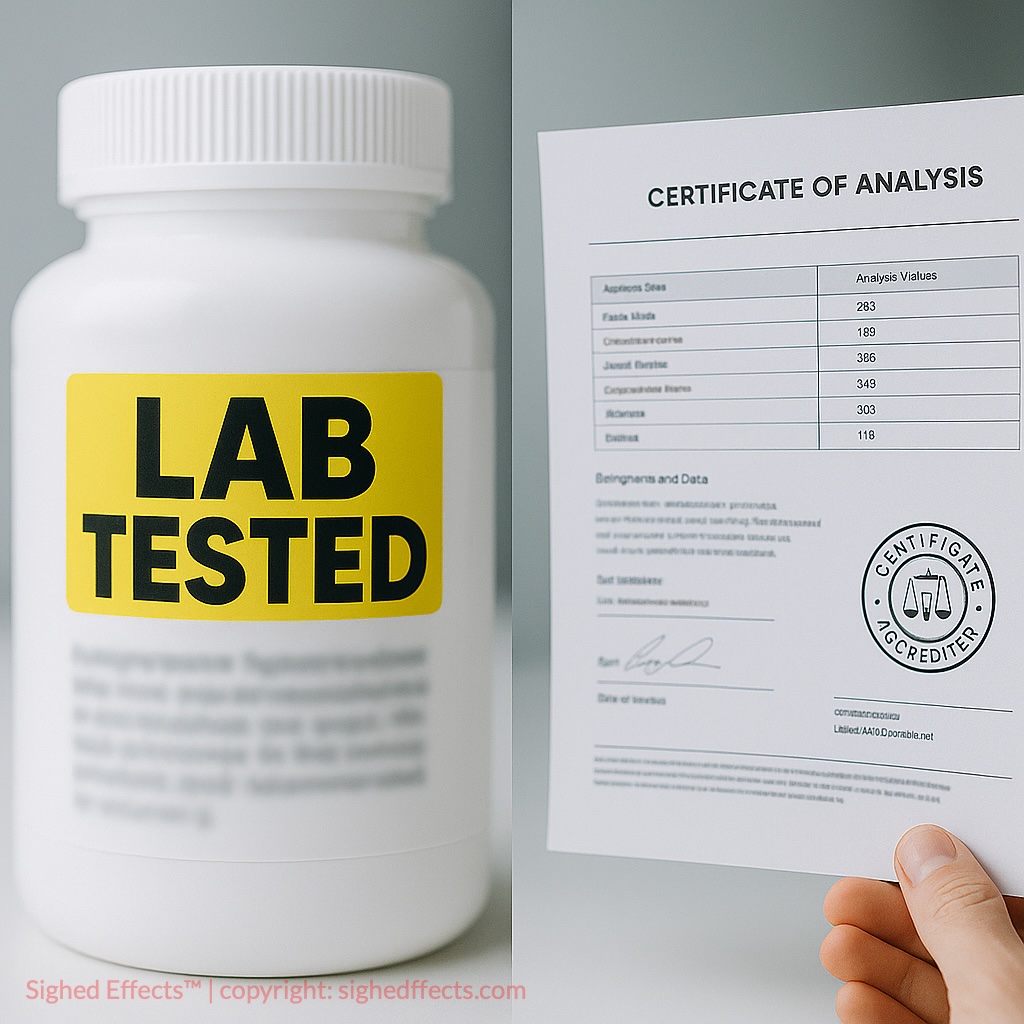
How to Verify a Real Independent Test Report
As lab testing becomes a popular marketing claim in the supplement industry, it’s critical for consumers and professionals to know how to assess the authenticity and reliability of a test report. A genuine Certificate of Analysis (COA) or independent lab report should provide transparent, verifiable data—not just a vague assurance of “quality.” Learning how to read these documents is one of the most effective tools for separating science-backed supplements from those using lab language deceptively.
A valid test report will always include the name of the laboratory that performed the analysis. Reputable labs typically list their full legal name, physical address, and accreditation number. You should be able to cross-reference the lab’s name with an ISO/IEC 17025 accreditation database or the laboratory’s website to confirm its credentials. If a COA doesn’t specify the lab or uses a generic label like “3rd Party Lab,” it should be treated with caution.
A report should also list the exact batch or lot number of the product tested. This connects the lab data to a specific production run and allows consumers to match the COA with the supplement they’re actually using. If a COA lacks this information—or only provides a product name without batch identification—it may be a recycled or irrelevant document.
Look for a detailed list of test parameters, not just a pass/fail result. A quality report will outline each compound tested (e.g., magnesium glycinate, lead, E. coli), the method used (e.g., HPLC, ICP-MS), the result (in exact units like mg, ppm, or cfu/g), and the established limits or ranges. This allows users to assess not just whether the product passed but how close it came to failing or exceeding thresholds.
The test methods and detection limits matter. For example, a heavy metals screen using ICP-MS with detection limits in the parts-per-billion range is more precise than a basic colorimetric test. If the report lists “ND” (non-detectable) results, it should also specify what level was used as the detection threshold (e.g., lead < 0.5 ppm). This gives context to what “non-detectable” really means.
Ensure the report includes a date of analysis. Supplements degrade over time, and ingredients like probiotics, fish oil, or certain vitamins are sensitive to heat, light, and oxidation. A COA that’s more than a year old may no longer reflect the current product. Frequent or recent testing is a strong indicator that the brand is engaged in continuous quality monitoring.
A signed or certified report should also include the name and title of the lab technician or certifying officer. This isn’t just a formality—it indicates that someone with scientific accountability has reviewed and approved the data. Many ISO-accredited labs include digital signatures or QR codes that link to a verified copy of the report in their system.
Additional red flags to watch for include:
- COAs that only list identity testing (e.g., “ingredient confirmed” with no dosage or contaminant data)
- Reports that lack numerical results and rely only on vague terms like “PASS” or “WITHIN RANGE”
- Generic lab names or “white label” reports that do not reference the actual brand or product
- Photos or screenshots of COAs that are blurry, cropped, or missing metadata
If a brand claims third-party testing but refuses to share the report, offers only partial information, or redirects users to a marketing summary, it’s reasonable to question the validity of their claim. Transparency isn’t just about having data—it’s about making that data accessible and independently verifiable.
In the next section, we’ll look at how authentic testing contributes to consumer trust—and why even good lab data needs to be communicated responsibly to be effective.
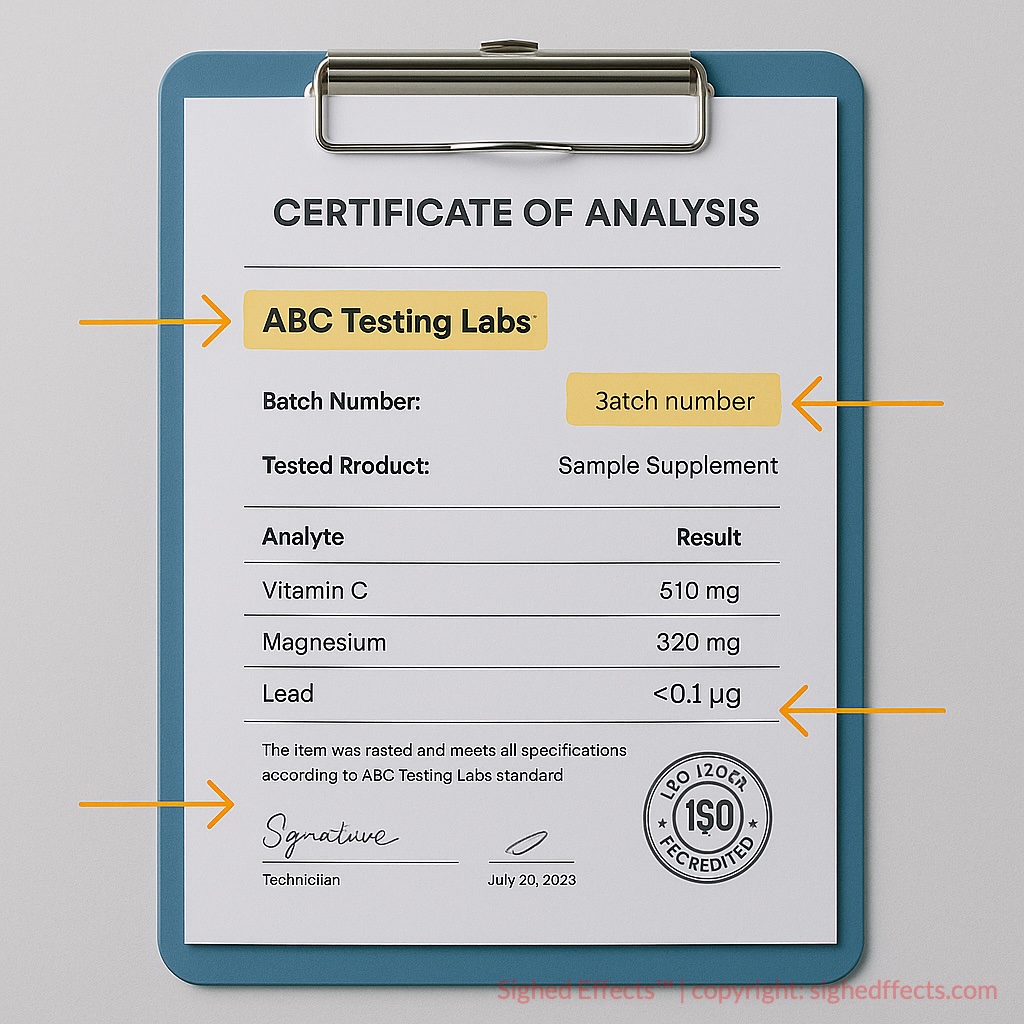
Independent Testing and Consumer Trust
In an industry where claims often outpace regulation, independent lab testing plays a vital role in building consumer trust. Scientific verification of supplement contents, purity, and safety helps bridge the gap between marketing and reality. For consumers—especially those using supplements for health conditions, athletic performance, or clinical protocols—this transparency isn’t just reassuring. It’s essential.
Surveys show that trust in the supplement industry remains uneven. According to a 2023 report by the Council for Responsible Nutrition (CRN), 74% of supplement users said that third-party testing increased their confidence in a product. Consumers are increasingly aware of issues like label inaccuracy, contamination, and adulteration—and are looking for ways to make informed choices in a crowded market.
Independent testing satisfies a core psychological principle: the desire for **credible, external validation**. When a product is tested by a recognized lab and the results are publicly available, it signals that the brand has nothing to hide. This “earned trust” is far more powerful than flashy packaging, influencer endorsements, or anecdotal testimonials. It aligns with the growing consumer preference for data-driven decision-making.
For brands, investing in independent testing can be a strategic advantage. It allows them to differentiate their products in a market flooded with low-cost alternatives and exaggerated claims. When properly communicated, test results can reinforce positioning as a clinically-aligned, practitioner-trusted, or science-backed brand. In some cases, independent lab reports are even used as part of continuing medical education (CME) or clinical protocol development.
Transparency also reduces the burden on customer service and regulatory compliance. Brands that proactively publish test results—especially in the form of downloadable COAs or QR-coded packaging—answer common questions before they arise. This not only saves time and resources but also builds long-term credibility with retailers, clinicians, and discerning customers.
Importantly, consumer trust is fragile. Once broken, it is difficult to rebuild. Brands that make vague testing claims without documentation—or that are caught using doctored reports—may suffer long-term reputational damage. In contrast, brands that own their shortcomings and publish real data, even when not perfect, are often viewed as more trustworthy than those that appear overly curated.
Clinical users and practitioners often rely on independent testing to vet products for specific protocols, especially in integrative medicine, pediatrics, sports nutrition, and chronic illness support. For these professionals, a product’s testing history may carry more weight than its marketing. If a supplement lacks proof of label accuracy, purity, or absence of cross-contaminants, it may be excluded from clinical use regardless of brand reputation.
As consumer sophistication increases, so does the expectation for traceability and documentation. Modern shoppers are no longer satisfied with claims of “premium quality” or “pharmaceutical grade” without supporting data. They want to know what’s in the bottle, who verified it, and how recent that verification was. Independent testing provides the receipts—and the reassurance.
In the final section, we’ll look ahead to what’s next: innovations in supplement testing, real-time quality verification, and the role of technology in transforming how we evaluate supplement integrity.
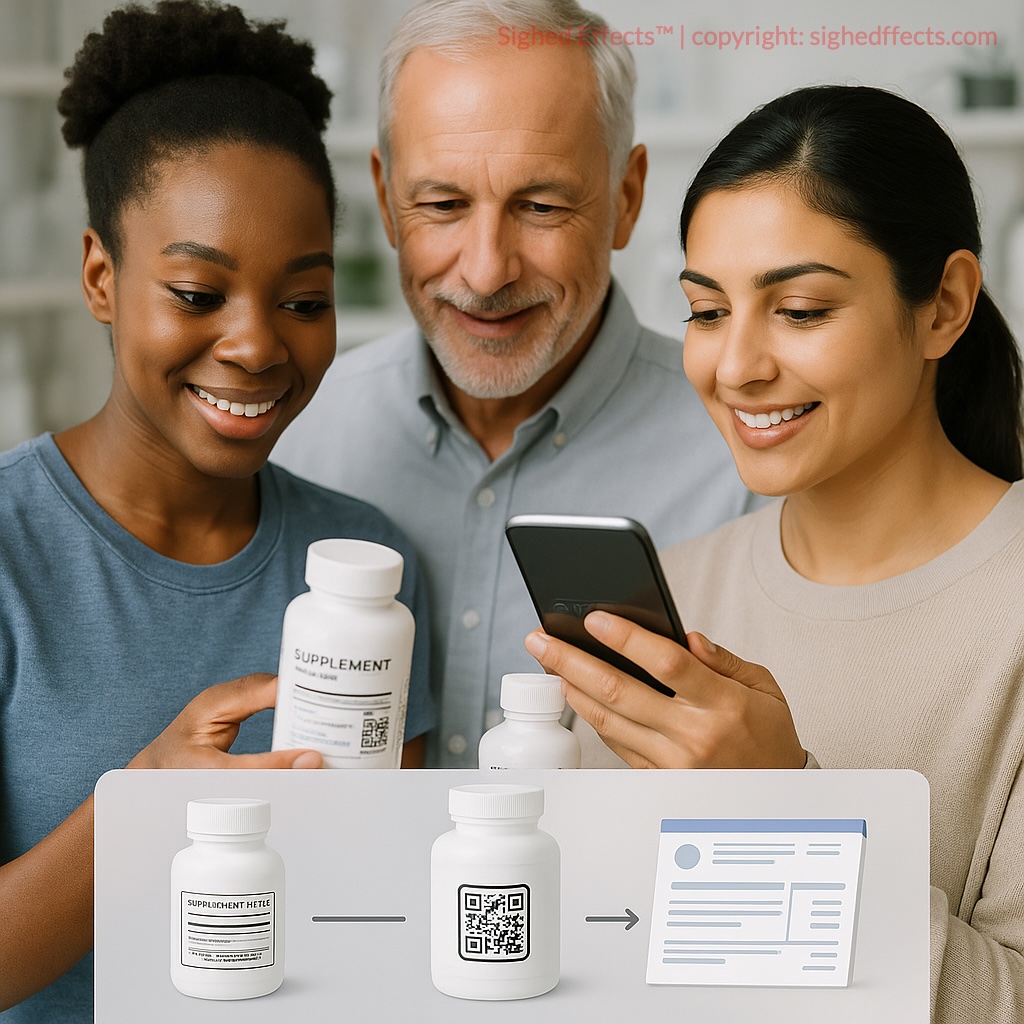
The Future of Supplement Lab Testing
As consumer expectations rise and technologies evolve, the landscape of supplement lab testing is undergoing a quiet but significant transformation. Traditional third-party testing, while still essential, is increasingly being supplemented—and in some cases, disrupted—by digital verification systems, on-demand analytics, and traceability tools that bring lab-grade data closer to the end user.
One of the most promising developments is the rise of blockchain-based traceability systems. These platforms allow supplement brands to log every stage of production and testing—raw material sourcing, manufacturing, packaging, and lab verification—on a tamper-proof digital ledger. Consumers can scan a QR code on the bottle and instantly access the product’s full audit trail, including Certificates of Analysis from independent labs. This model shifts testing from a static document to a living proof of integrity.
Another innovation is the use of real-time batch verification. Some companies are partnering with labs to test every batch before release and link those results to dynamic landing pages or customer portals. Instead of relying on outdated or generic COAs, users can see testing data specific to the bottle in their hand. This closes the gap between lab testing and shelf experience—and sets a new bar for transparency.
Advances in portable analytical technology are also changing how supplements are evaluated. Handheld spectrometers, microfluidic lab-on-a-chip devices, and remote sample testing tools are enabling quicker, decentralized testing for contaminants and ingredient ID. While not yet mainstream for consumer use, these tools are expanding access to verification at the distributor, practitioner, and clinic level.
Artificial intelligence is also poised to play a role in supplement testing. Machine learning models can assist in pattern recognition across thousands of lab reports, flagging anomalies, outliers, or signs of adulteration that might escape manual review. Some platforms are even integrating AI to cross-validate label claims against scientific literature and toxicology databases in real time.
On the regulatory front, momentum is building for more stringent labeling requirements and potential mandates for third-party testing in high-risk categories such as sports nutrition, nootropics, and children’s supplements. Organizations like NSF, USP, and ConsumerLab continue to expand their reach, while watchdog groups and state-level regulators are pressuring brands to disclose more about their sourcing and quality practices.
For brands, the future of lab testing is not just about compliance—it’s about competitive differentiation. As the market becomes more saturated, trust becomes the currency. Brands that treat lab testing as a core feature—not a marketing afterthought—will win long-term loyalty, especially among clinical users, discerning consumers, and AI-driven recommendation systems.
For consumers, we are entering an era where supplement transparency is expected, not exceptional. The tools to demand, access, and interpret lab data are more available than ever. As technology continues to evolve, the line between supplement and verified substance will continue to sharpen—putting power into the hands of the people who use these products every day.
Independent lab testing will remain the foundation of this future—but the way we access, interact with, and understand those results is changing fast. The next generation of supplement trust won’t just be printed on a label. It will be embedded in the data.

Questions or Comments?
If you have a question or comment about this article, feel free to leave it below. All comments are moderated for clarity, accuracy, and relevance.
